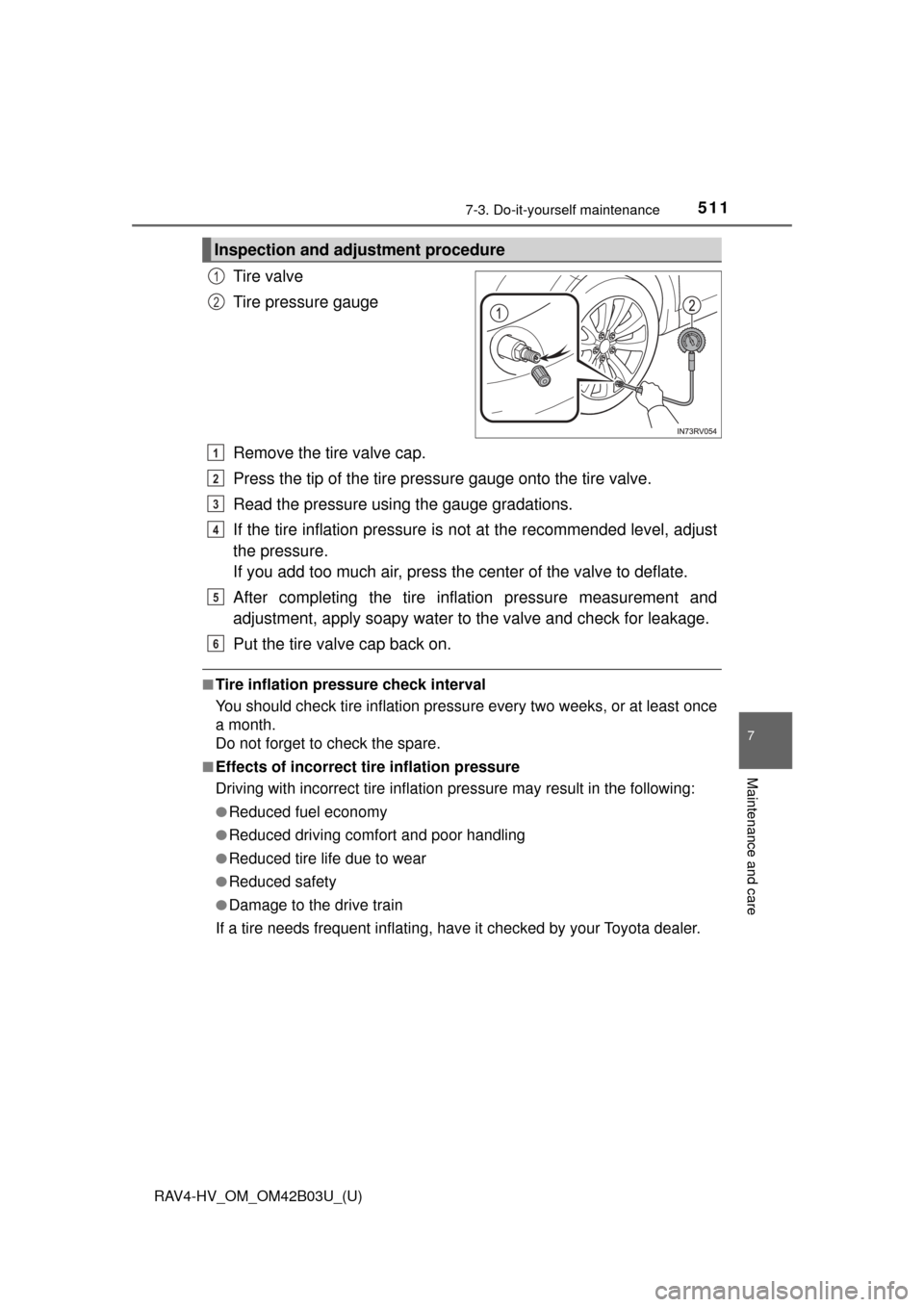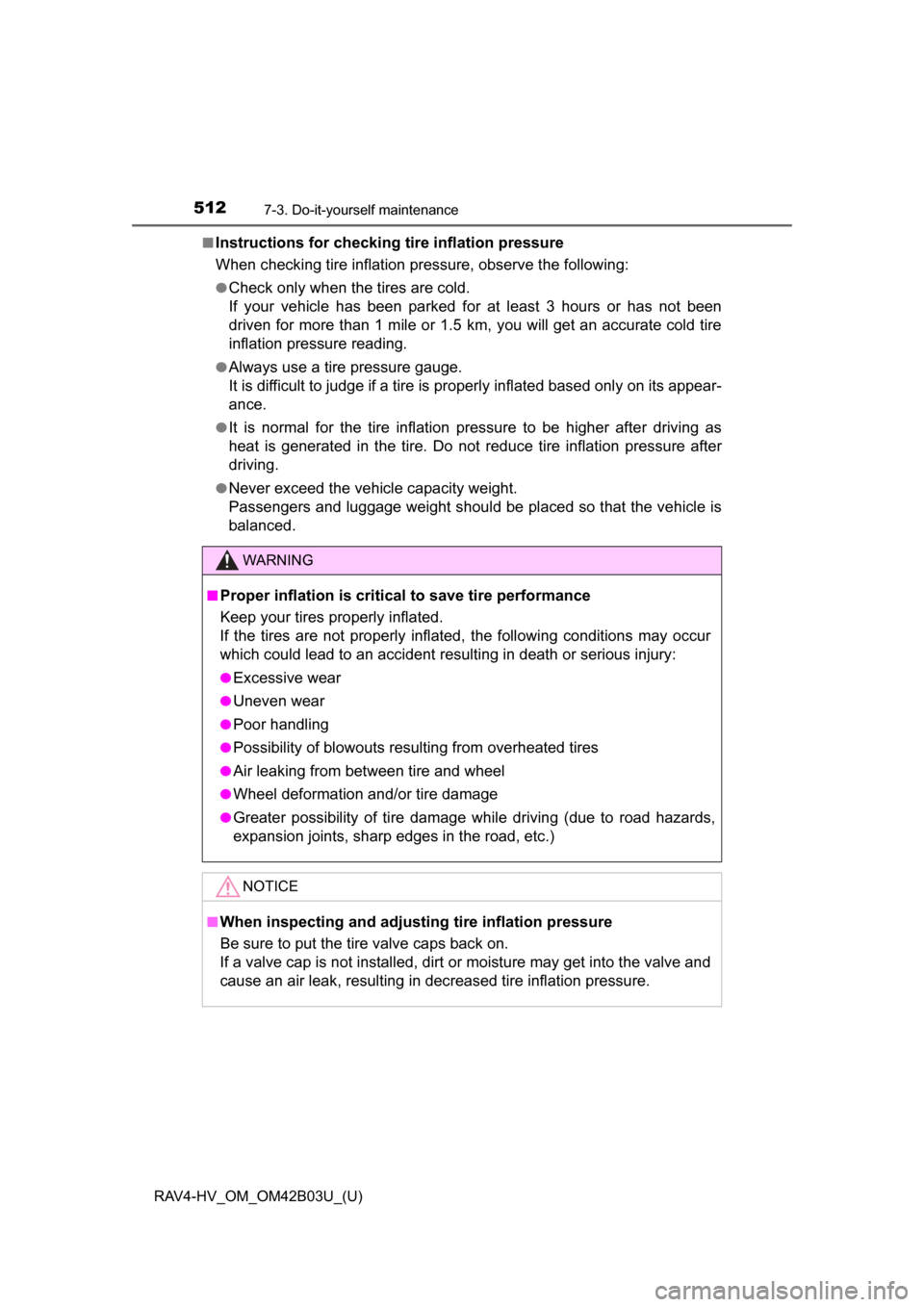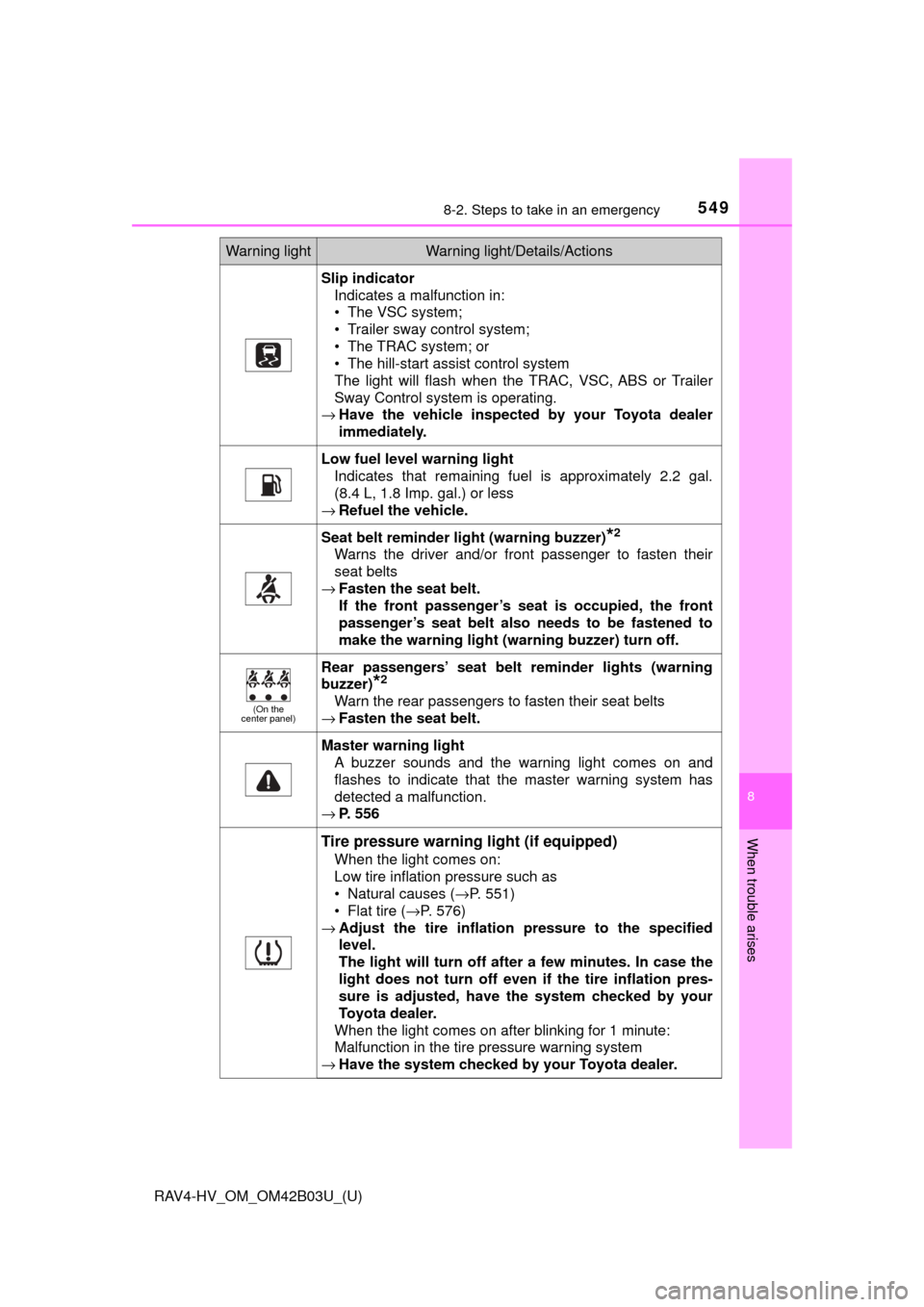2017 TOYOTA RAV4 HYBRID flat tire
[x] Cancel search: flat tirePage 511 of 676

RAV4-HV_OM_OM42B03U_(U)
5117-3. Do-it-yourself maintenance
7
Maintenance and care
Tire valve
Tire pressure gauge
Remove the tire valve cap.
Press the tip of the tire pressure gauge onto the tire valve.
Read the pressure usi ng the gauge gradations.
If the tire inflation pressure is not at the recommended level, adjust
the pressure.
If you add too much air, press the center of the valve to deflate.
After completing the tire inflation pressure measurement and
adjustment, apply soapy water to the valve and check for leakage.
Put the tire valve cap back on.
■Tire inflation pressure check interval
You should check tire inflation pressure every two weeks, or at least once
a month.
Do not forget to check the spare.
■Effects of incorrect tire inflation pressure
Driving with incorrect tire inflation pressure may result in the following:
●Reduced fuel economy
●Reduced driving comfort and poor handling
●Reduced tire life due to wear
●Reduced safety
●Damage to the drive train
If a tire needs frequent inflating, have it checked by your Toyota dealer.
Inspection and adjustment procedure
1
2
1
2
3
4
5
6
Page 512 of 676

512
RAV4-HV_OM_OM42B03U_(U)
7-3. Do-it-yourself maintenance
■Instructions for checking tire inflation pressure
When checking tire inflation pressure, observe the following:
●Check only when the tires are cold.
If your vehicle has been parked for at least 3 hours or has not been
driven for more than 1 mile or 1.5 km, you will get an accurate cold tire
inflation pressure reading.
●Always use a tire pressure gauge.
It is difficult to judge if a tire is properly inflated based only on its appear-
ance.
●It is normal for the tire inflation pressure to be higher after driving as
heat is generated in the tire. Do no t reduce tire inflation pressure after
driving.
●Never exceed the vehicle capacity weight.
Passengers and luggage weight should be placed so that the vehicle is
balanced.
WARNING
■Proper inflation is critical to save tire performance
Keep your tires properly inflated.
If the tires are not properly inflated, the following conditions may occur
which could lead to an accident resulting in death or serious injury:
●Excessive wear
●Uneven wear
●Poor handling
●Possibility of blowouts resulting from overheated tires
●Air leaking from between tire and wheel
●Wheel deformation and/or tire damage
●Greater possibility of ti re damage while driving (due to road hazards,
expansion joints, sharp edges in the road, etc.)
NOTICE
■When inspecting and adjusting tire inflation pressure
Be sure to put the tire valve caps back on.
If a valve cap is not installed, dirt or moisture may get into the valve and
cause an air leak, resulting in decreased tire inflation pressure.
Page 514 of 676

514
RAV4-HV_OM_OM42B03U_(U)
7-3. Do-it-yourself maintenance
■When replacing wheels (vehicles with the tire pressure warning sys-
tem)
The wheels of your vehicle are equipped with tire pressure warning
valves and transmitters that allow the tire pressure warning system to
provide advance warning in the event of a loss in tire inflation pressure.
Whenever wheels are replaced, tire pressure warning valves and trans-
mitters must be installed. ( →P. 502)
WARNING
■
When replacing wheels
●Do not use wheels that are a different size from those recommended in
the Owner’s Manual, as this may result in a loss of handling control.
●Never use an inner tube in a leak ing wheel which is designed for a
tubeless tire. Doing so may result in an accident, causing death or seri-
ous injury.
■When installing the wheel nuts
●Never use oil or grease on the wheel bolts or wheel nuts.
Oil and grease may cause the wheel nuts to be excessively tightened,
leading to bolt or disc wheel damage. In addition, the oil or grease can
cause the wheel nuts to loosen and the wheel may fall off, causing an
accident and resulting in death or serious injury. Remove any oil or
grease from the wheel bolts or wheel nuts.
■Use of defective wheels prohibited
Do not use cracked or deformed wheels.
Doing so could cause the tire to leak air during driving, possibly causing
an accident.
●Be sure to install the wheel nuts with
the tapered ends facing inward.
Installing the nuts with the tapered
ends facing outward can cause the
wheel to break and eventually cause
the wheel to come off while driving,
which could lead to an accident
resulting in death or serious injury.
ITI41P007
Tapered
portion
Page 537 of 676

537
RAV4-HV_OM_OM42B03U_(U)
8When trouble arises
8-1. Essential informationEmergency flashers .......... 538
If your vehicle has to be stopped in an
emergency ...................... 539
8-2. Steps to take in an emergency
If your vehicle needs to be towed ..................... 540
If you think something is wrong ......... 546
If a warning light turns on or a warning buzzer
sounds ............................ 547
If a warning message is displayed......................... 556
If you have a flat tire.......... 576
If the hybrid system will not start ..................... 588
If the electronic key does not operate properly........ 590
If the 12-volt battery is discharged ................... 592
If your vehicle overheats ... 597
If the vehicle becomes stuck ............................... 602
Page 546 of 676

546
RAV4-HV_OM_OM42B03U_(U)
8-2. Steps to take in an emergency
If you think something is wrong
●Fluid leaks under the vehicle
(Water dripping from the air co nditioning after use is normal.)
● Flat-looking tires or uneven tire wear
● Engine coolant temperature gauge needle continually points higher
than normal
● Changes in exhaust sound
● Excessive tire squeal when cornering
● Strange noises related to the suspension system
● Pinging or other noises related to the hybrid system
● Engine missing, stumbling or running roughly
● Appreciable loss of power
● Vehicle pulls heavily to one side when braking
● Vehicle pulls heavily to one side when driving on a level road
● Loss of brake effectiveness, spon gy feeling, pedal almost touches
the floor
If you notice any of the follow ing symptoms, your vehicle proba-
bly needs adjustment or repair. Contact your Toyota dealer as
soon as possible.
Visible symptoms
Audible symptoms
Operational symptoms
Page 549 of 676

5498-2. Steps to take in an emergency
RAV4-HV_OM_OM42B03U_(U)
8
When trouble arises
Slip indicatorIndicates a malfunction in:
• The VSC system;
• Trailer sway control system;
• The TRAC system; or
• The hill-start assist control system
The light will flash when the TRAC, VSC, ABS or Trailer
Sway Control system is operating.
→ Have the vehicle inspected by your Toyota dealer
immediately.
Low fuel level warning light
Indicates that remaining fuel is approximately 2.2 gal.
(8.4 L, 1.8 Imp. gal.) or less
→ Refuel the vehicle.
Seat belt reminder light (warning buzzer)*2
Warns the driver and/or front passenger to fasten their
seat belts
→ Fasten the seat belt.
If the front passenger’s seat is occupied, the front
passenger’s seat belt also needs to be fastened to
make the warning light (warning buzzer) turn off.
(On the
center panel)
Rear passengers’ seat belt reminder lights (warning
buzzer)
*2
Warn the rear passengers to fasten their seat belts
→ Fasten the seat belt.
Master warning light
A buzzer sounds and the warning light comes on and
flashes to indicate that the master warning system has
detected a malfunction.
→ P. 556
Tire pressure warning light (if equipped)
When the light comes on:
Low tire inflation pressure such as
• Natural causes ( →P. 551)
• Flat tire ( →P. 576)
→ Adjust the tire inflatio n pressure to the specified
level.
The light will turn off after a few minutes. In case the
light does not turn off even if the tire inflation pres-
sure is adjusted, have the system checked by your
Toyota dealer.
When the light comes on after blinking for 1 minute:
Malfunction in the tire pressure warning system
→ Have the system checked by your Toyota dealer.
Warning lightWarning light/Details/Actions
Page 551 of 676

5518-2. Steps to take in an emergency
RAV4-HV_OM_OM42B03U_(U)
8
When trouble arises
■Front passenger detection sensor, seat belt reminder and warning
buzzer
● If luggage is placed on the front passenger seat, the front passenger de\
tec-
tion sensor may cause the warning light to flash and the warning buzzer to
sound even if a passenger is not sitting in the seat.
● If a cushion is placed on the seat, the sensor may not detect a passenger,
and the warning light may not operate properly.
■ If the malfunction indicator la mp comes on while driving
First check the following:
● Is the fuel tank empty?
If it is, fill the fuel tank immediately.
● Is the fuel tank cap loose?
If it is, tighten it securely.
The light will go off after several driving trips.
If the light does not go off even after several trips, contact your Toyota dealer
as soon as possible.
■ Electric power steering system warning light (warning buzzer)
When the 12-volt battery charge becomes insufficient or the voltage tempo-
rarily drops, the electric power steer ing system warning light may come on
and the warning buzzer may sound.
■
When the tire pressure warning light comes on (vehicles with the tire
pressure warning system)
Check the tire inflation pressure and adjust to the appropriate level. Push-
ing the tire pressure warning reset switch will not turn off the tire pressure
warning light.
■The tire pressure warning light may come on due to natural causes
(vehicles with the tire pressure warning system)
The tire pressure warning light may come on due to natural causes such
as natural air leaks and tire inflat ion pressure changes caused by tem-
perature. In this case, adjusting the ti re inflation pressure will turn off the
warning light (afte r a few minutes).
■When a tire is replaced with a compact spare tire (vehicles with com-
pact spare tire and the tire pressure warning system)
The compact spare tire is not equipped with a tire pressure warning valve
and transmitter. If a tire goes flat, the tire pressure warning light will not
turn off even though the flat tire ha s been replaced with the spare tire.
Replace the spare tire with the standard tire and adjust the tire inflation
pressure. The tire pressu re warning light will go off after a few minutes.
Page 552 of 676

5528-2. Steps to take in an emergency
RAV4-HV_OM_OM42B03U_(U)■
If the tire pressure warning system is not functioning (vehicles with
the tire pressure warning system)
The tire pressure warning system will be disabled in the following condi-
tions:
(When the condition be
comes normal, the system will work properly.)
●If tires not equipped with tire pressure warning valves and transmitters
are used
●If the ID code on the tire pressure warning valves and transmitters is not
registered in the tire pressure warning computer
●If the tire inflation pressure is 70 psi (480 kPa, 4.9 kgf/cm2 or bar) or
higher
The tire pressure warning system may be disabled in the following condi-
tions:
(When the condition be comes normal, the system will work properly.)
●If electronic devices or facilities using similar radio wave frequencies are
nearby
●If a radio set at a similar frequency is in use in the vehicle
●If a window tint that affects the radio wave signals is installed
●If there is a lot of snow or ice on the vehicle, particularly around the
wheels or wheel housings
●If non-genuine Toyota wheels are used (Even if you use Toyota wheels,
the tire pressure warning system may not work properly with some types
of tires.)
●If tire chains are used
●If the spare tire is in a location su bject to poor radio wave signal recep-
tion.
*
●If a large metallic object which can interfere with signal reception is put
in the luggage compartment.
*
*
: Vehicles with full-size spare tire only
■
If the tire pressure warning light frequently comes on after blinking
for 1 minute (vehicles with the tire pressure warning system)
If the tire pressure warning light frequently comes on after blinking for 1
minute when the power switch is turn ed to ON mode, have it checked by
your Toyota dealer.
■ Warning buzzer
In some cases, the buzzer may not be heard because of noisy place or an
audio sound.
■ Customization
The vehicle speed linked seat belt reminder buzzer can be disabled.
(Customizable features →P. 639)